Commonly, when you insert a USB drive in the USB port on a Mac computer, the drive will soon appear on the desktop or hide in the Finder, letting you access, view, and manage data on it. However, Pendrive or USB not showing up on Mac sometimes happens, as a Quora user encountered:
Hi, I have an iMac Pro running macOS 12.2.1 Monterey. I have a Seagate USB external drive with a file archive on it. Last week, it was working fine. This week, the computer will not see the drive. From Quora
Why is the flash drive not showing up on your Mac? What are the effective solutions to make your USB drive recognized on a Mac? This page covers all the possible fixes for USB drives not showing up on Mac, which also applies to external hard drives not showing up on Mac or SD cards not showing up on Mac. Take a quick glance at the main content and directly jump to the part you're most interested in.
| Workable Solutions | Step-by-step Troubleshooting |
|---|---|
| Check connection issue | Reconnect the USB drive and plug it into another USB port or on a Mac; Check the port...Full steps |
| Show USB flash drive | Show the external USB disk in Finder Preferences or check it in the System Information...Full steps |
|
Repair USB drive with First Aid |
If the USB flash drive is corrupted or damaged, go to Applications > Utilities > Disk Utility...Full steps |
| More effective fixes | More useful ways can solve Mac USB not showing up like using Terminal, restoring data and formatting USB, upgrading macOS...Full steps |
Why Is My USB Not Showing Up on the Mac
The reasons behind the problem of a USB device not showing up are various, including:
| ❌Wrong connection | The USB drive is not properly connected to the port. |
| 🙁USB port issue | The USB port is not working and is broken. |
| 💾USB corrupted | The USB flash drive is damaged or due to a corrupted file system. |
| 📌macOS faulty | If your current Mac system has a bug, it can cause your external drive to have read-and-write problems or not detect the issue. |
| ⚡USB not turning on | The drive is not turned on (this is rare, but some models of USB drives have a physical power switch). |
| 👿virus infection | If your USB flash drive is infected with a virus, it may not show up on your Mac. |
Before learning how to fix the issue of your USB flash drive not showing on your Mac, consider restoring the essential data to avoid data loss. In this guide, we also talk about how to recover files from a disappeared USB flash drive.
Restore Data from the Non-Recognized USB
Disk reformatting solves many hard drive issues, including the not showing up USB, particularly when you can see the USB icon but files are not showing. USB drive showing empty makes no sense, so you have to reformat the disk and make it usable again.
⚠️Note that reformatting will erase data. As long as the data matters, you need to follow the standard procedure to ensure zero data loss.
Step 1. Download EaseUS Data Recovery Wizard for Mac, the professional Mac data recovery software, to perform a full USB drive data recovery.
If you want to know the selection and details of this year's best data recovery software, click this link.
You Can Trust EaseUS Data Recovery Software
EaseUS Data Recovery Wizard has acquired an extensive technical base in data recovery and trusted by billions of users since 2005. Check out reviews on Trustpilot.
Use this Mac USB recovery tool to easily retrieve files from a USB flash drive in three steps:
- 1. Start EaseUS Data Recovery Wizard for Mac.
- 2. Scan your USB flash drive for lost files.
- 3. Preview and restore the files from the USB drive.
Step 2. Reformat the USB drive in Disk Utility.
- 1. Go to "Utilities" and open "Disk Utility".
- 2. Select the USB flash drive that is not showing up in the Disk Utility sidebar.
- 3. Click "Erase" on the top.
- 4. Finish the necessary information (name, format, and scheme) to format the USB flash drive.
Be a part of the tutorial! Share this valuable information on your social media to help others with the same problem.
How to Fix USB Flash Drive Not Showing on a Mac
To find an effective solution for your own case, take the time to conduct some basic checks, rule out irrelevant issues, identify potential risks, and then address them. We also provide a video guide on how to fix the issue of the USB flash drive not showing on a Mac.

Fix 1. Reconnect the USB Drive or Change the USB Port
Have you tried to restart your Mac once or twice? Before taking further measures, don't forget the most efficient way to tackle commonplace hardware glitches that arise occasionally. If this operating system restarting fails to solve the current problem, move on to check the physical connection issue step by step.
Step 1. Plug the USB drive out from the not working USB port and change to the other USB port. Try all the available USB ports on your Mac.
Step 2. Did you use a USB connection cable or a USB-C adapter? If yes, take the USB drive out and directly plug it in the USB port.
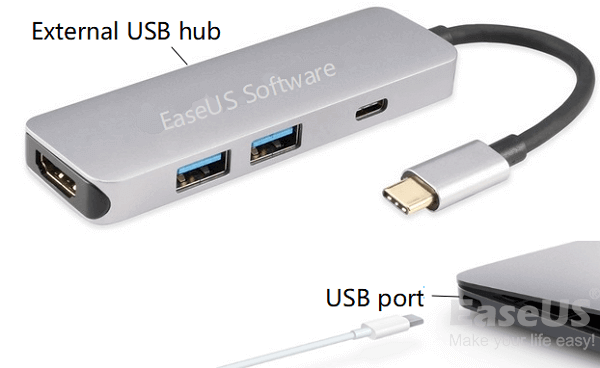
Step 3. Is there another Mac computer available to you? If yes, try to connect the USB drive to this computer.
The three steps of troubleshooting a USB drive not showing up on a Mac are very basic. However, it is quite helpful in most cases. Each step can help us exclude the issues of a bad/loose connection, a not working USB port, a lack of power, and other superficial phenomena.
If the USB flash drive is corrupted or damaged, don't panic! Install this powerful and trusted USB flash drive data recovery tool to rescue your important data first!
Recover Deleted Files on Mac for Free
This guide covers how to recover deleted files from Mac-compatible devices - including internal and external drives, cards, and USBs - in various scenarios.
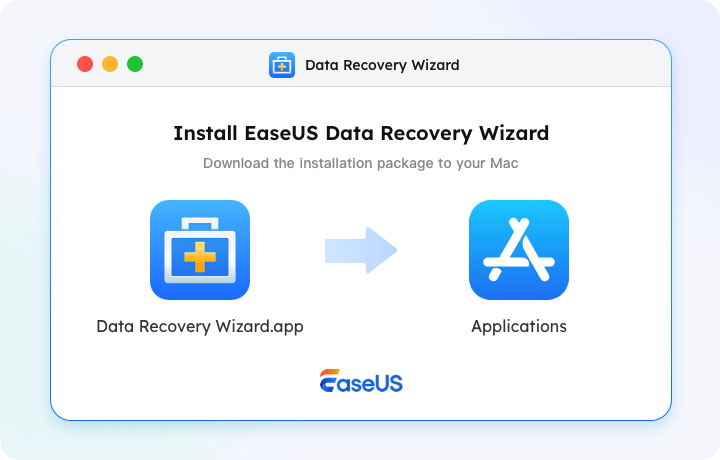
Fix 2. Show USB Flash Drive on the Desktop Mac
Occasionally, your Mac has already recognized the USB flash drive but has not shown it on the desktop. Thus, you should go to "Finder > Preferences > General" and make sure the "External disks" option is ticked. Then you'll see the USB flash drive showing up on the Mac desktop.
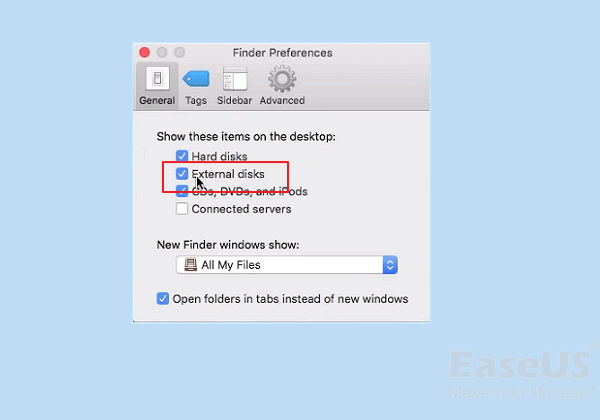
Fix 3. Show External USB Drive in the Finder
Finder is the other access for us to check a connected external drive on Mac. If your flash drive or pen drive is not showing up there, go to Finder > Preferences > Sidebar. Under Locations, you need to tick the option "External disks". This option ensures that the connected external USB hard drive or pen drive will normally appear in the Finder.
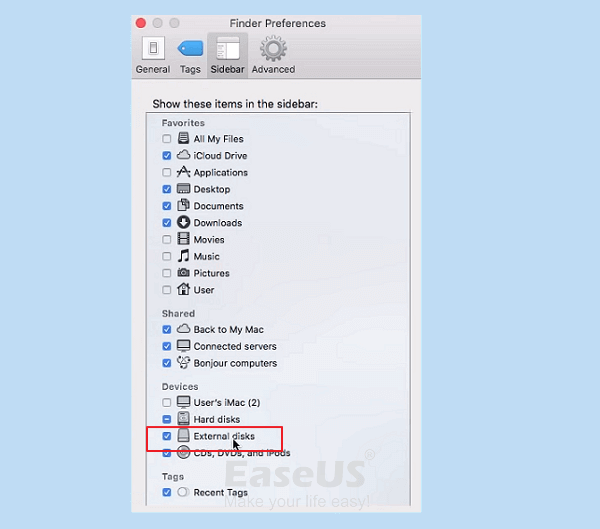
Fix 4. Check the USB Drive in the System Information
When you cannot find the USB drive on the desktop or in the Finder, try to look for it in the System Information section, which is usually a hidden place for average Mac users.
Step 1. Go to "Applications > Utilities > System Information".
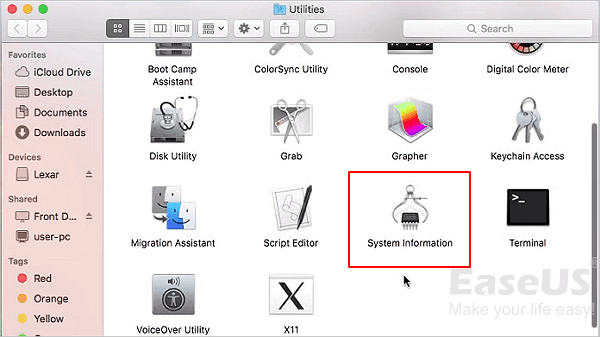
Step 2. Check if the system detects the USB drive. Click "USB" on the left panel and check the USB flash drive information.
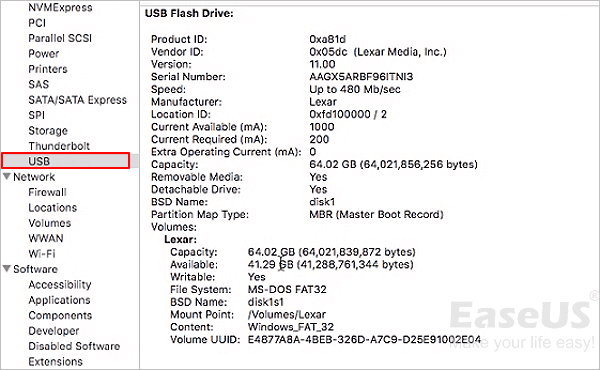
Did the above method help you fix the problem? If you solve it, remember to share it with your friends.
Fix 5. Reset USB Ports on Mac to Detect USB Drive
Step 1. Restart the Mac computer, and press the Command +Option+P+R keys until the Apple logo appears.
Step 2. Press the Command+Option+Esc keys to close all applications that are not responding.
Step 3. Plug the USB, which is not showing up on your Mac computer. If it doesn't show up, click the Apple icon and select "Sleep".
Step 4. Wake up the computer after a few seconds by pressing any key.
Step 5. Shut down the Mac, unplug the power cord, and reattach it after 15 seconds.
If this doesn't work, we should suspect the current corruption issue. Don't give up and try to do some repairs by yourself.
Fix 6. Repair USB Drive with First Aid
Step 1. Go to "Applications > Utilities > Disk Utility".
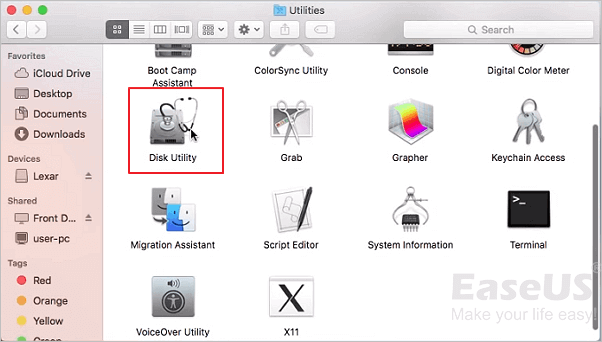
Step 2. Select the USB flash drive on the left panel of Disk Utility, click "First Aid" at the top toolbar, and click "Run". Disk Utility will repair any errors on the drive automatically.
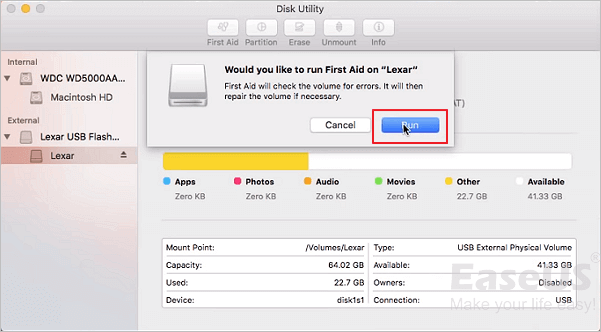
Step 3. Select the USB drive and click "Unmount" at the top toolbar. Unplug the USB and plug it back in 10-15 seconds.
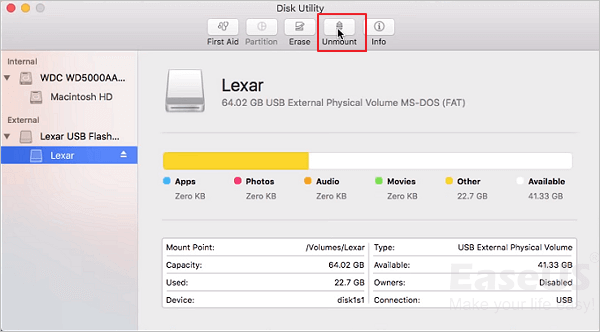
Suppose the First Aid process has failed; install the EaseUS USB flash drive recovery tool to save your unbacked-up data ASAP.
Fix 7. Solve Mac Not Recognizing USB Issue with Terminal
Step 1. Open Terminal in Utilities, type: diskutil list, and press Return.
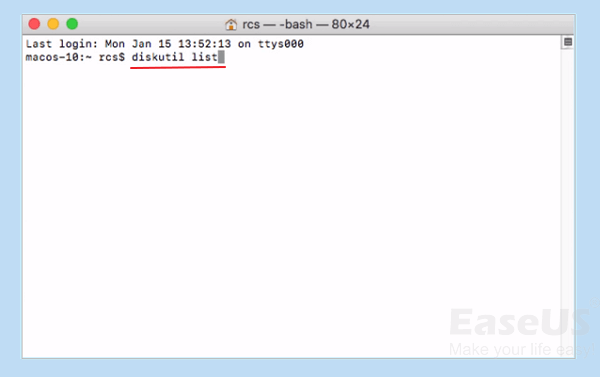
Step 2. Find the disk number of your USB flash drive, type diskutil info disk2, and press Return. (Replace 2 with the disk number of your USB flash drive.)
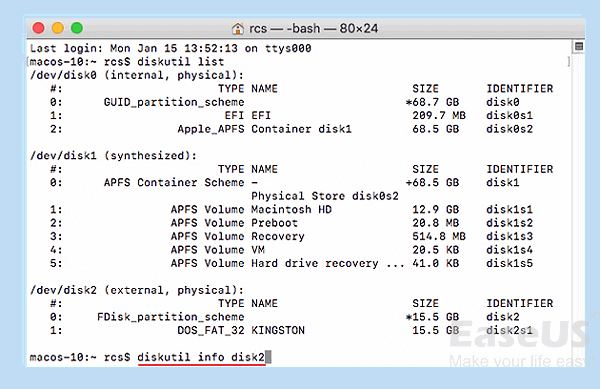
Step 3. Type diskutil eject disk 2, and press Return.
Step 4. Type diskutil list and press Return. When the USB disappears from the Terminal list, close the window.
Step 5. Close Terminal and open Console to inspect your drive errors.
Step 6. Click "Errors and Faults" to check if there are any errors.
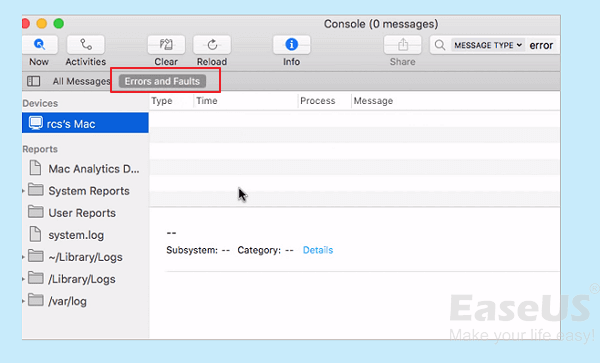
Step 7. Reconnect your USB flash drive back to your Mac. If no error shows up, your USB flash drive is safe.
Fix 8. Update Your macOS and Firmware
Did your Mac's OS keep updating all the time? Chances are that your Mac won't recognize a USB drive, especially after a macOS update. This time, Go to Settings and check whether your Mac is up-to-date. If there is an available update, upgrade your device in time.
Equally, firmware updates address various hardware issues, and the functionality of the USB ports could well be one of them. So, keep your software and firmware up to date will likely solve the Mac not recognizing USB device problem and make the USB drive appear normal again.
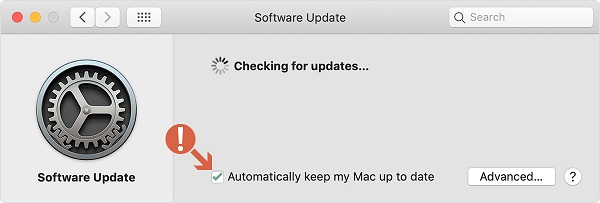
Fix 9. Send Your USB Drive to a Repair Center to Solve Mac Not Detecting USB Issue
Nowadays, even branded USB flash drives are not expensive. If you've tried all the suggested troubleshooting methods, the USB drive is still not showing up on Mac. You have to accept the truth that it's severely damaged and beyond your ability to repair it.
Mac won't recognize a badly damaged flash drive or pen drive since there is no way to show it up, even temporarily, which makes Mac data recovery difficult. The last chance for you to rescue data is to send the broken USB drive to a specialized data recovery service center nearby and let the professionals try their best.
You must prepare for the manual data recovery cost, which is noticeably higher than the software data recovery. Hence, always try the cost-effective plan of using EaseUS Data Recovery Wizard to scan the USB drive for the first attempt.
Mac Doesn't Recognize USB FAQs
More questions and answers on Mac not detecting pendrive or USB flash drive.
1. Why is my USB flash drive not showing up?
The reasons behind the problem of a USB device not showing up are various, including the USB port not working, USB drive corruption, virus infection, macOS faulty, and USB connection problems.
2. How do I get my Mac to recognize my flash drive?
To make Mac detect your external USB drive, first, you can do some basic settings to ensure the USB connection port and Mac system settings are normal. After the first round of checking, you can try to repair the corrupted USB drive by resetting USB ports, repairing the USB in Disk Utility, repairing the USB with Terminal, and reformatting the USB drive.
If Mac still doesn't recognize USB, continue checking macOS and software update issues.
3. How to fix the USB drive not showing files and folders on Mac?
To fix USB files not showing up on Mac, you can:
- Recover files or folders from a USB drive with Mac data recovery software
- Show hidden files on the USB flash drive
- Run First Aid to repair the USB drive when the device is corrupted
- Format to fix USB files not showing up on Mac
4. How do you fix an undetected USB on a Mac?
To solve the USB drive not showing up on Mac, try these ways:
- Reconnect the USB drive to your Mac
- Plug-in USB device to another USB port or another Mac
- Update the USB device drivers
- Show USB drive in Finder or desktop
- Repair corrupted USB
- Upgrade macOS
- Send your USB to a repair center
Wrap Things Up
On this page, we have collected 9 practical fixes for you to fix the USB not showing up on the Mac problem. Pick up one of the listed methods and follow the guide steps to make your drive show up and accessible again. If you need to format your USB drive, use EaseUS Mac data recovery software to recover files and troubleshoot without data loss.
Was This Page Helpful?
Jaden is one of the editors of EaseUS, who focuses on topics concerning PCs and Mac data recovery. Jaden is committed to enhancing professional IT knowledge and writing abilities. She is always keen on new and intelligent products.
Brithny is a technology enthusiast, aiming to make readers' tech lives easy and enjoyable. She loves exploring new technologies and writing technical how-to tips. In her spare time, she loves sharing things about her game experience on Facebook or Twitter.
-
EaseUS Data Recovery Wizard is a powerful system recovery software, designed to enable you to recover files you’ve deleted accidentally, potentially lost to malware or an entire hard drive partition.
Read More -
EaseUS Data Recovery Wizard is the best we have seen. It's far from perfect, partly because today's advanced disk technology makes data-recovery more difficult than it was with the simpler technology of the past.
Read More -
EaseUS Data Recovery Wizard Pro has a reputation as one of the best data recovery software programs on the market. It comes with a selection of advanced features, including partition recovery, formatted drive restoration, and corrupted file repair.
Read More
Related Articles
-
Fix USB Drive Not Showing Up in Windows10/11 | 8 Excellent Ways
![author icon]() Tracy King/Dec 12, 2025
Tracy King/Dec 12, 2025 -
Disk Utility Not Loading? Effective Solutions to Fix Disk Utility Not Loading Issue
![author icon]() Brithny/Dec 12, 2025
Brithny/Dec 12, 2025 -
Files Not Showing Up on Flash Drive Mac | How to Fix
![author icon]() Dany/Dec 12, 2025
Dany/Dec 12, 2025 -
Why My Pen Drive Is Not Showing in PC? How to Fix?
![author icon]() Tracy King/Dec 12, 2025
Tracy King/Dec 12, 2025